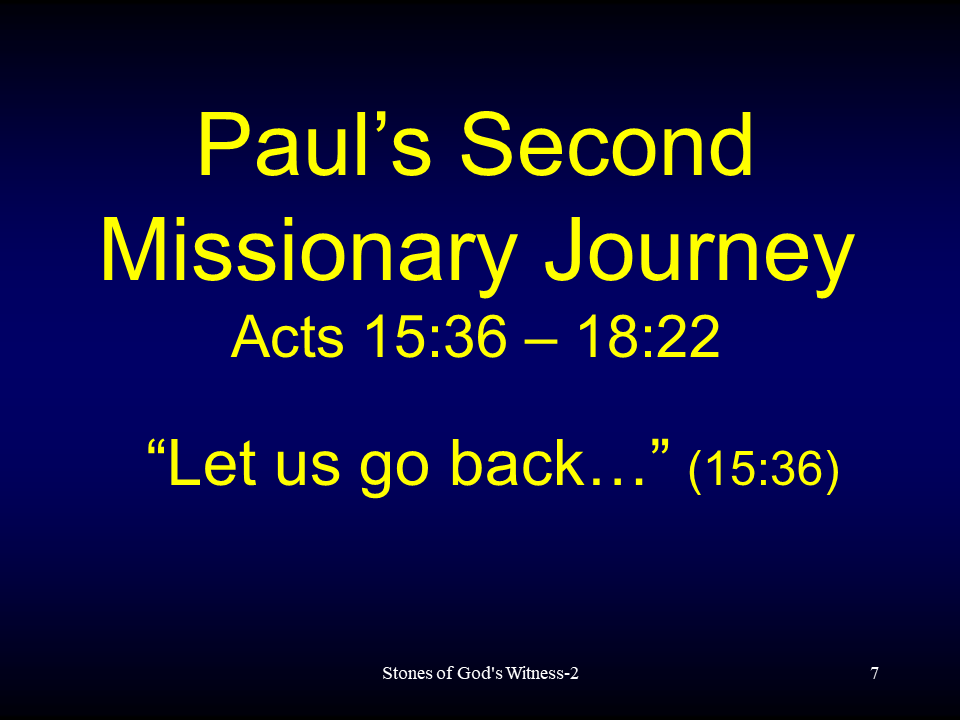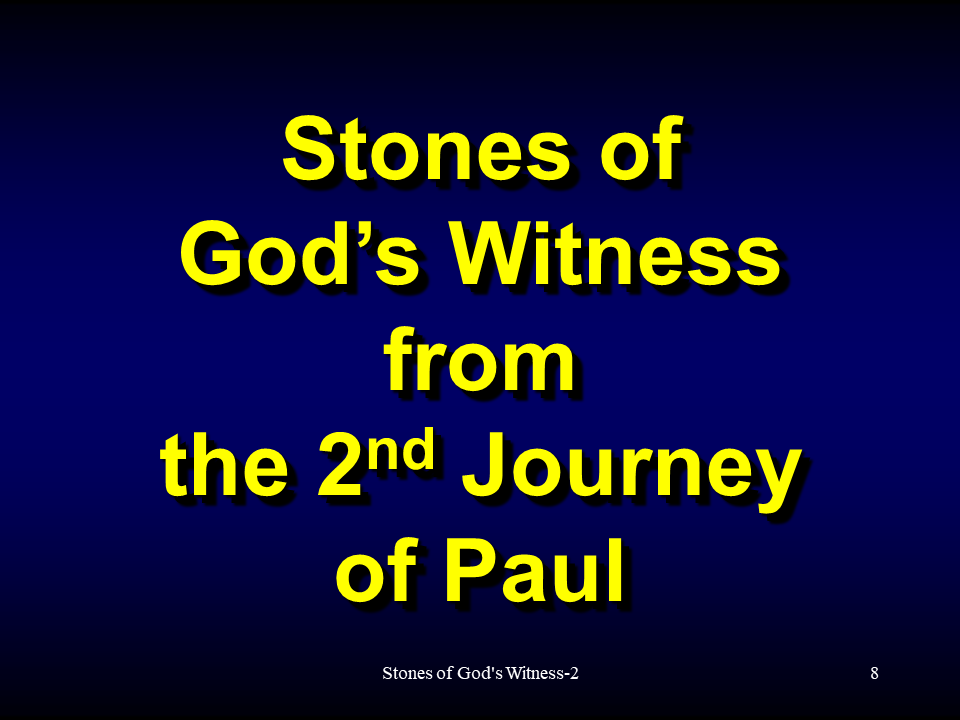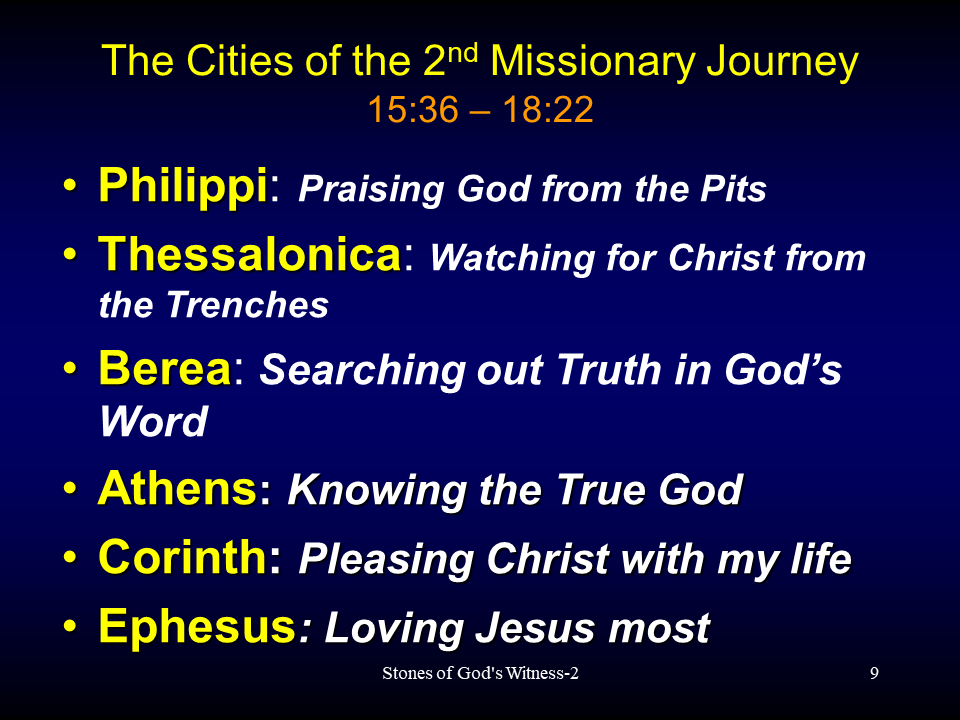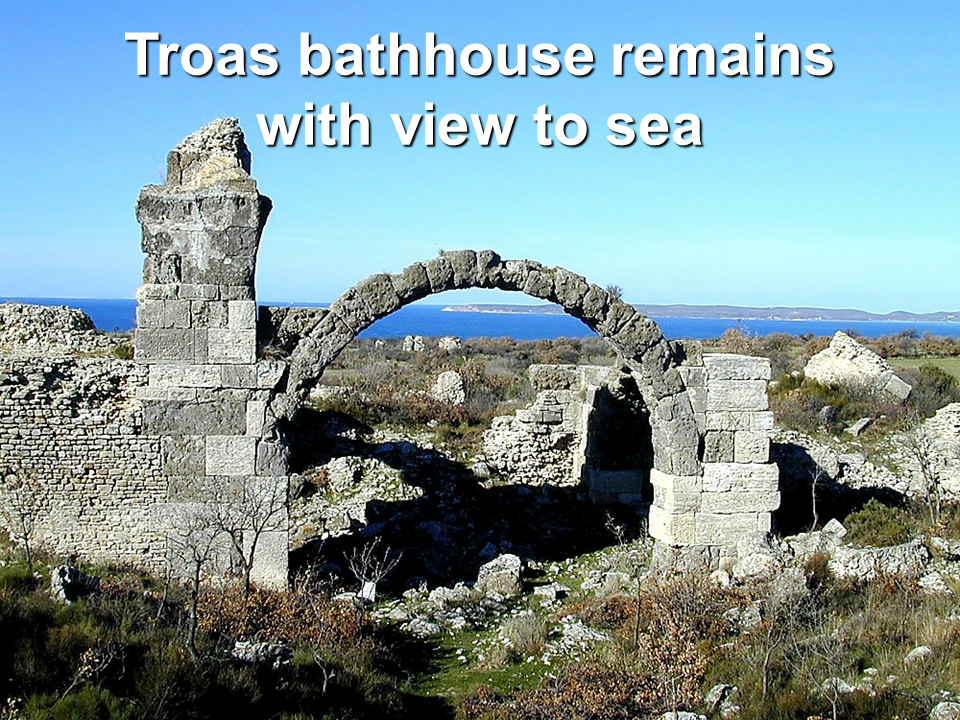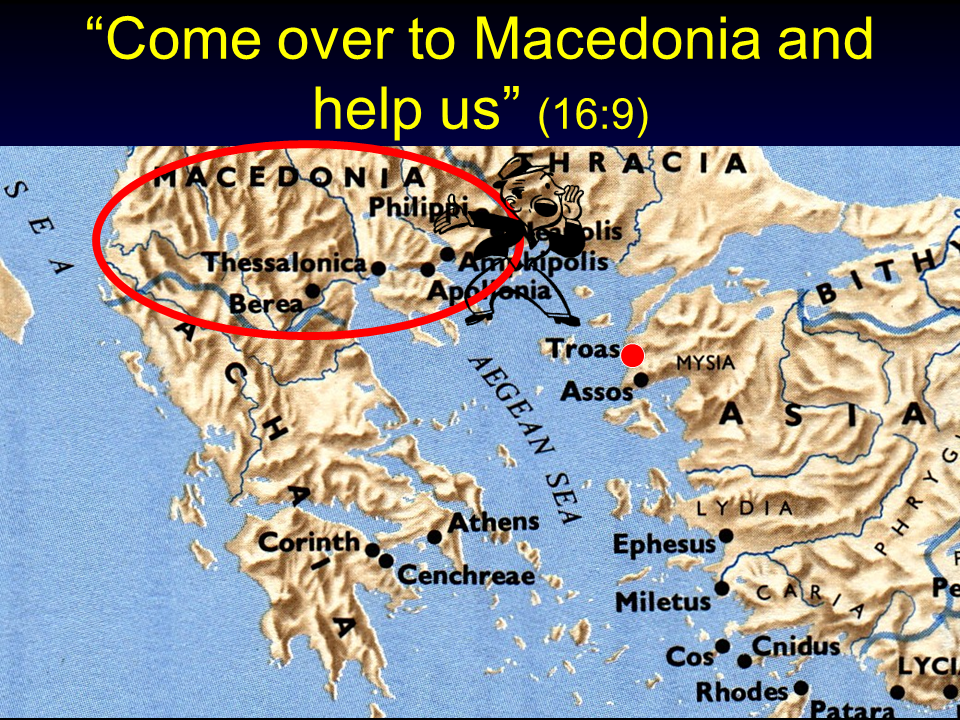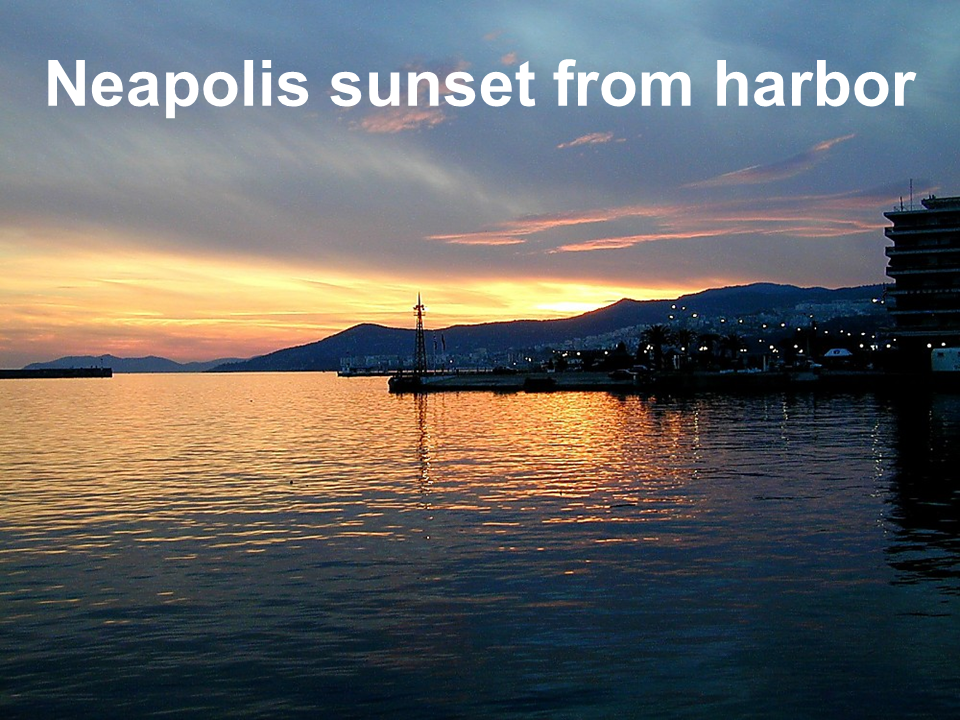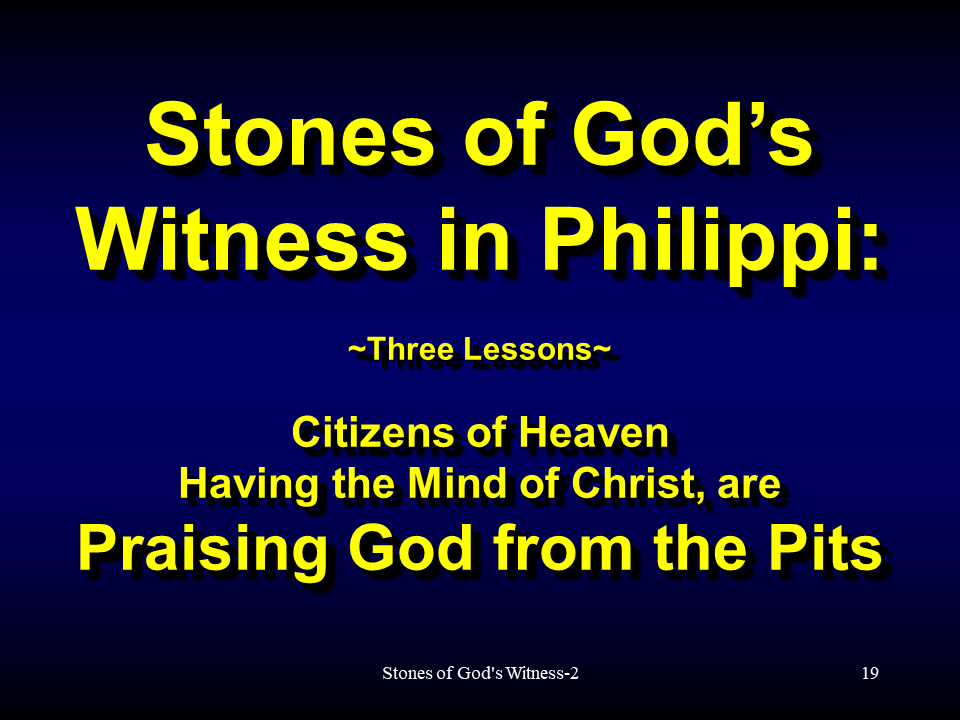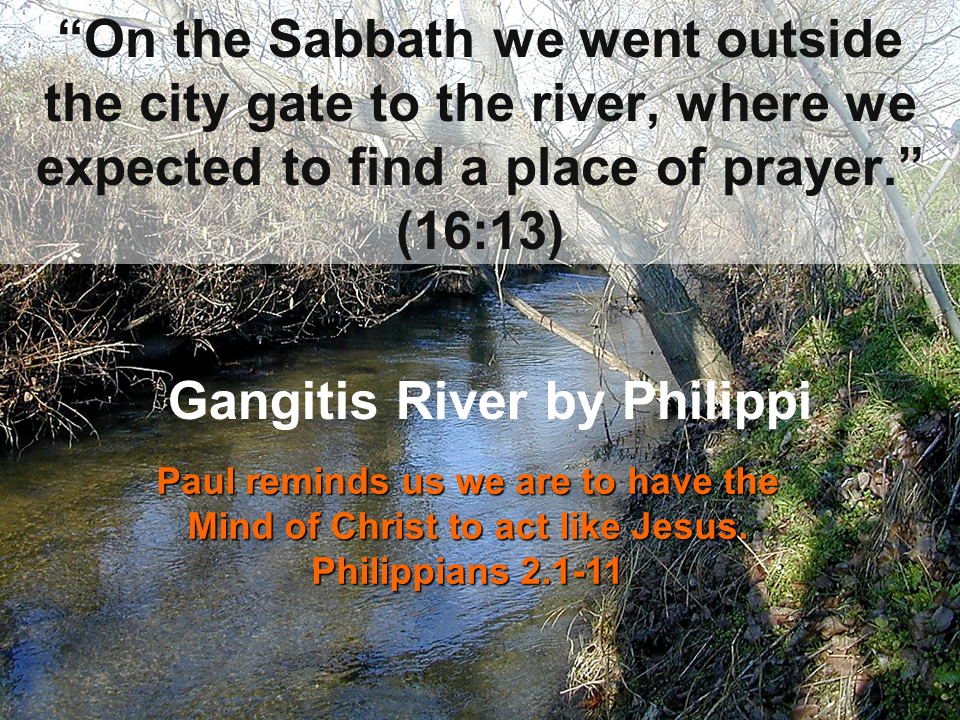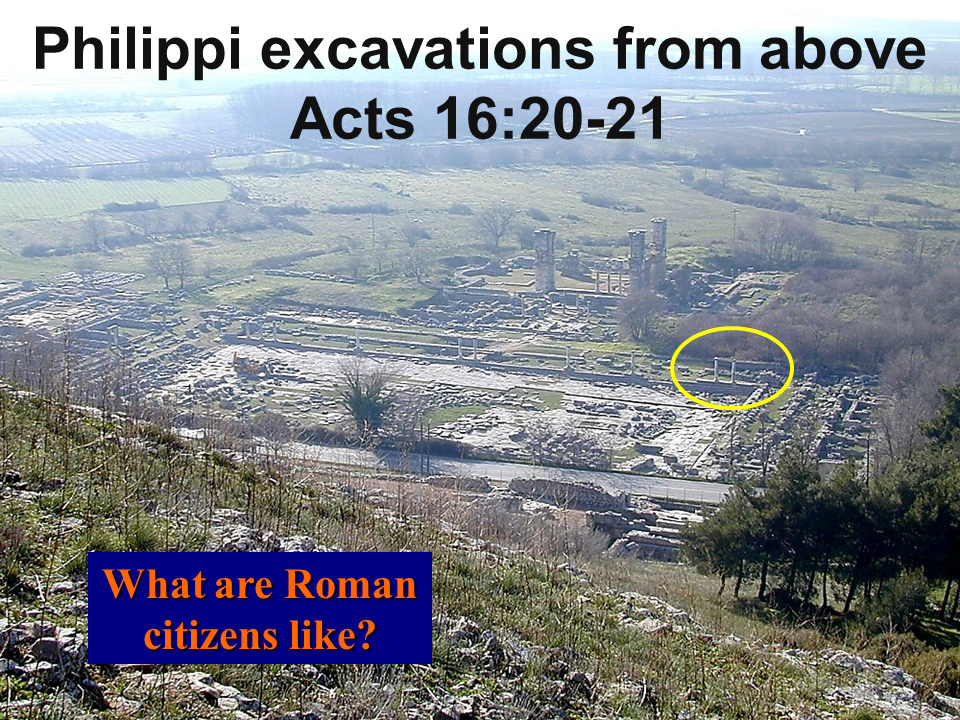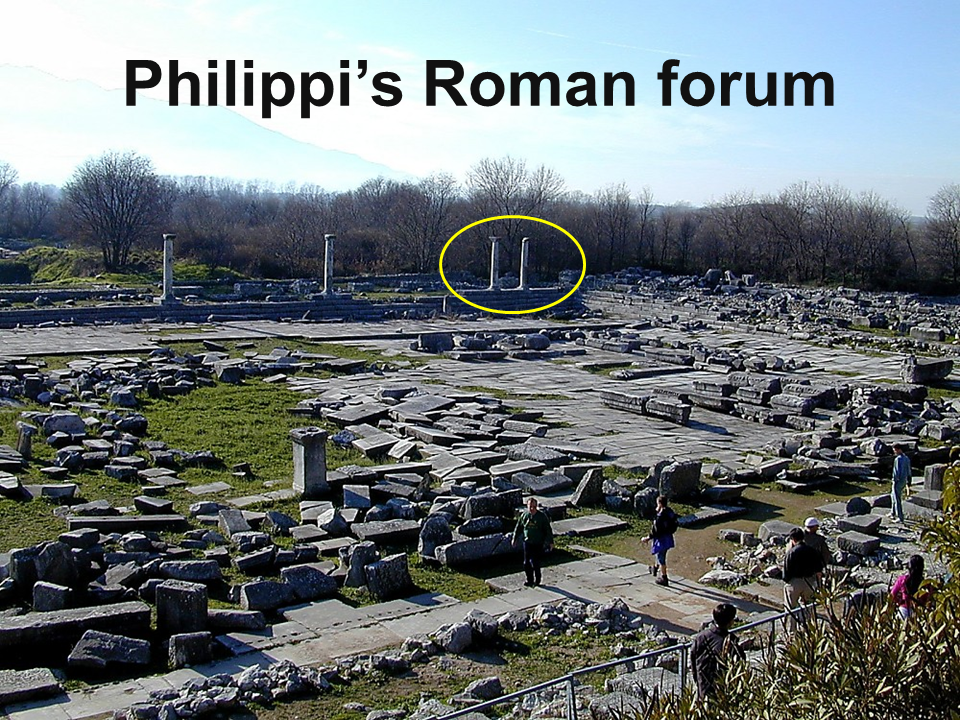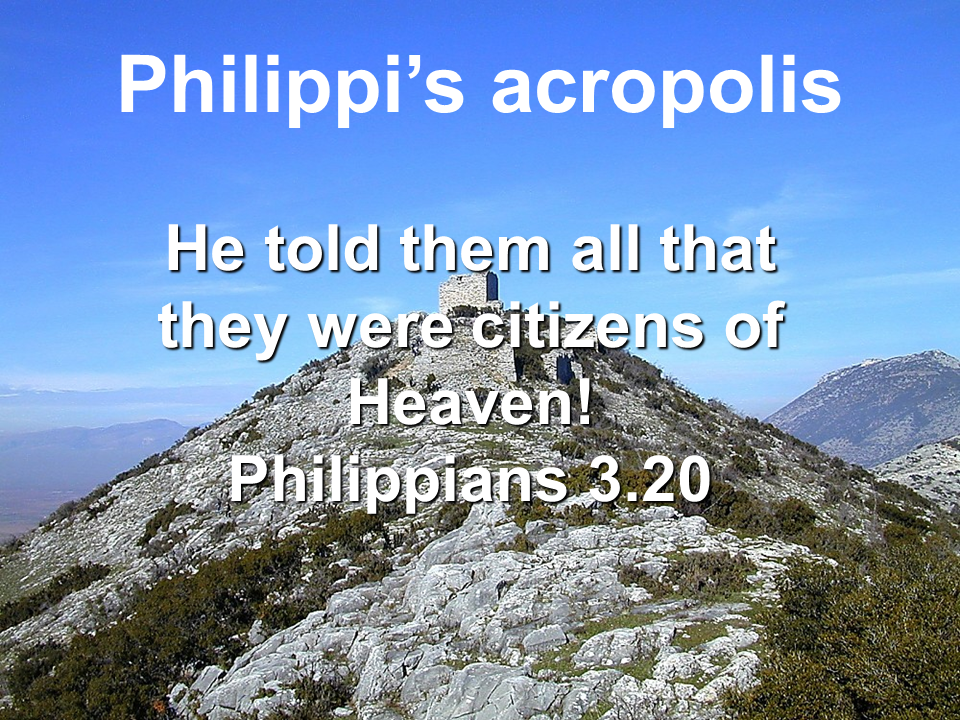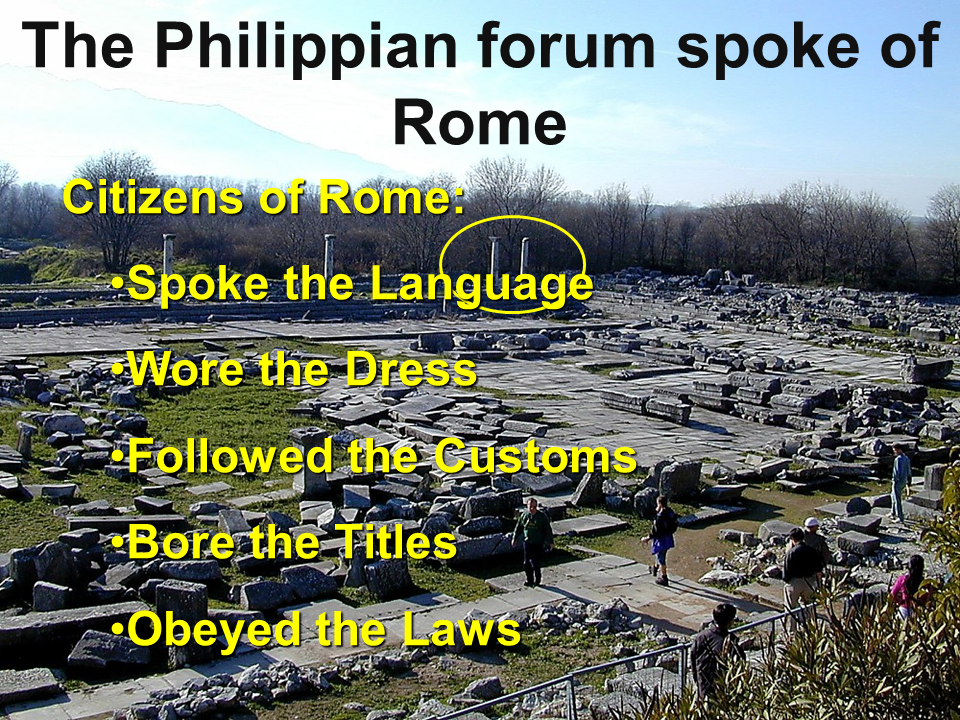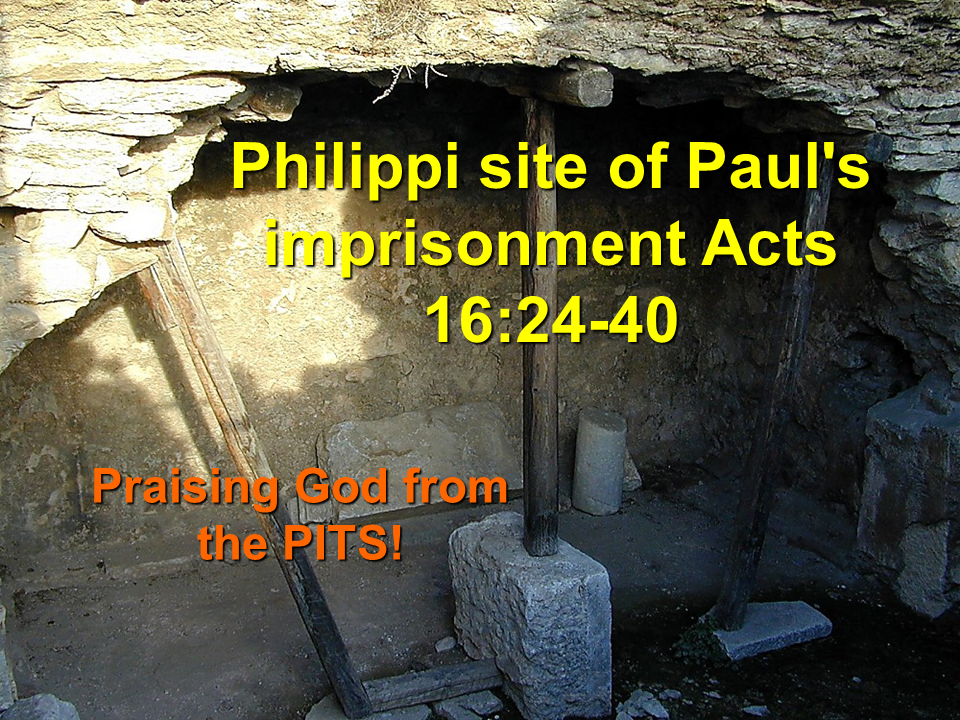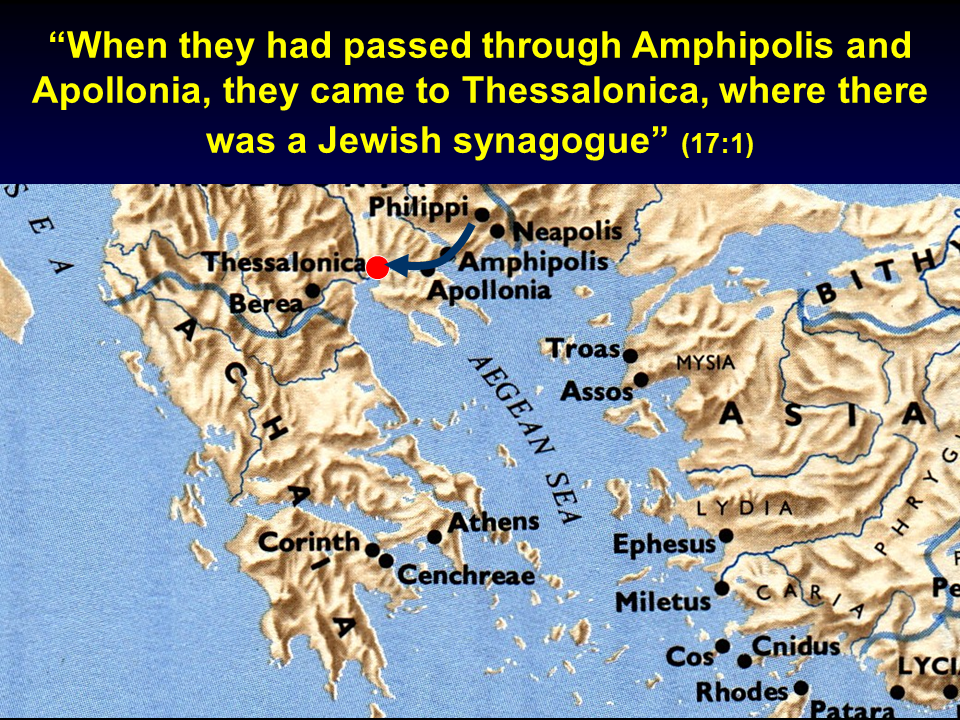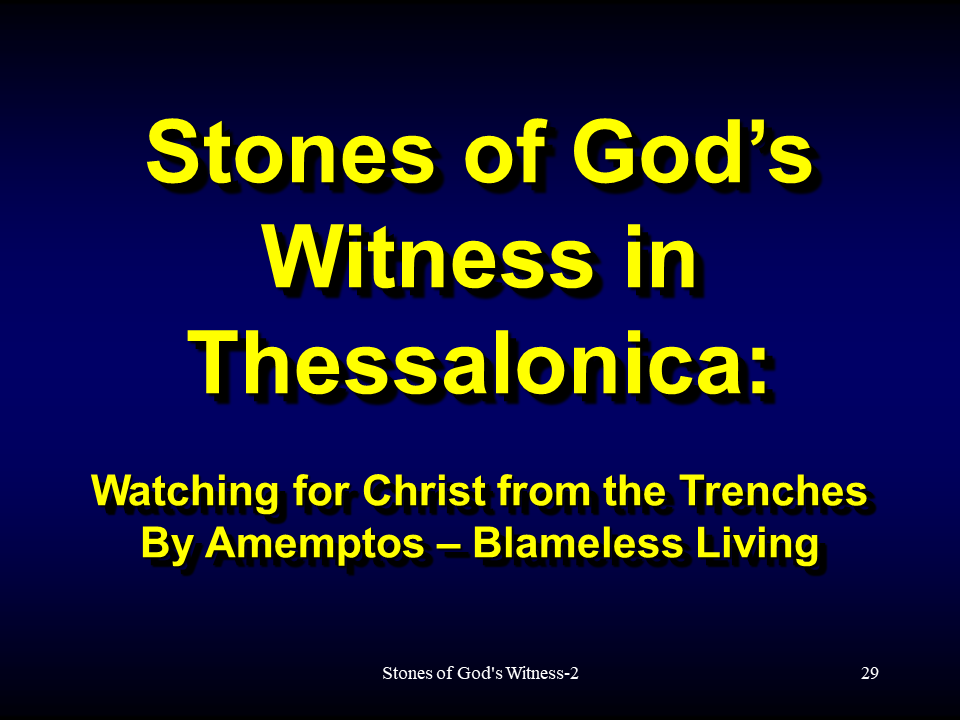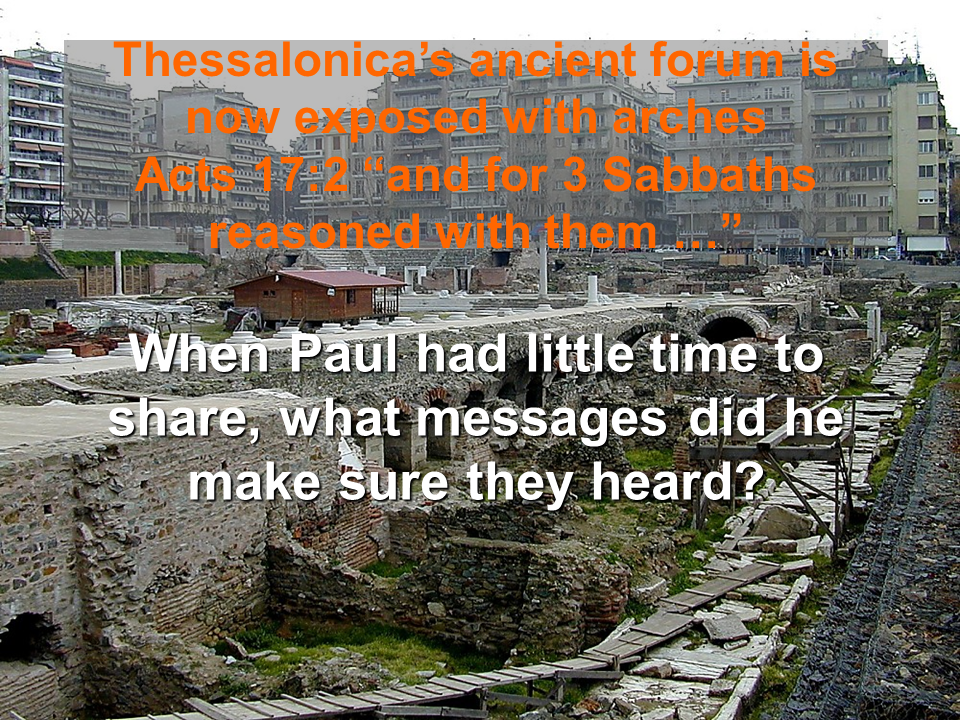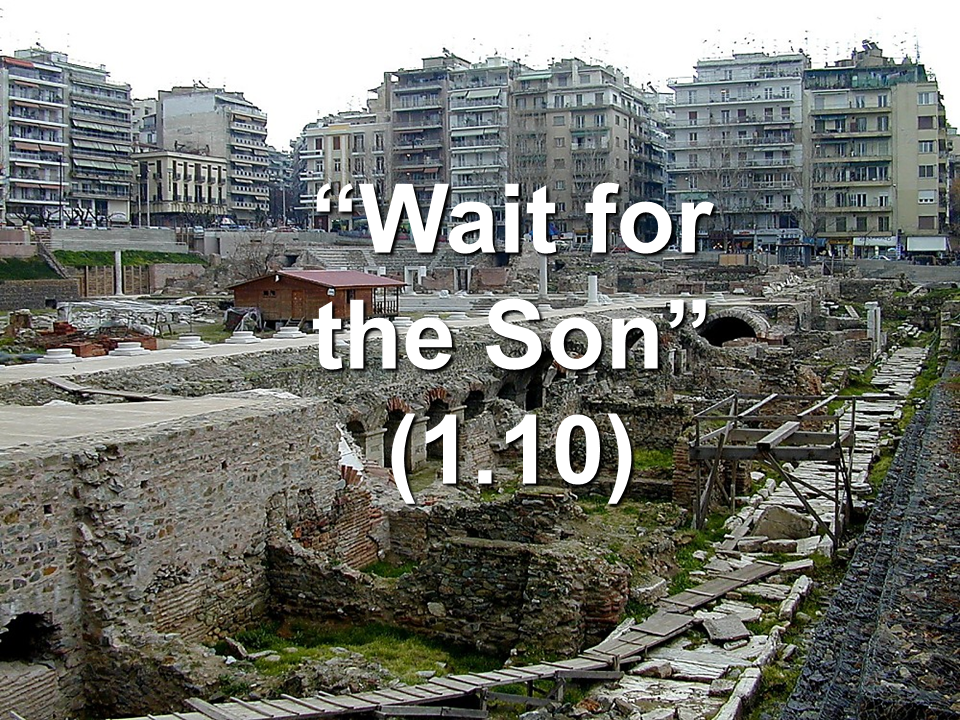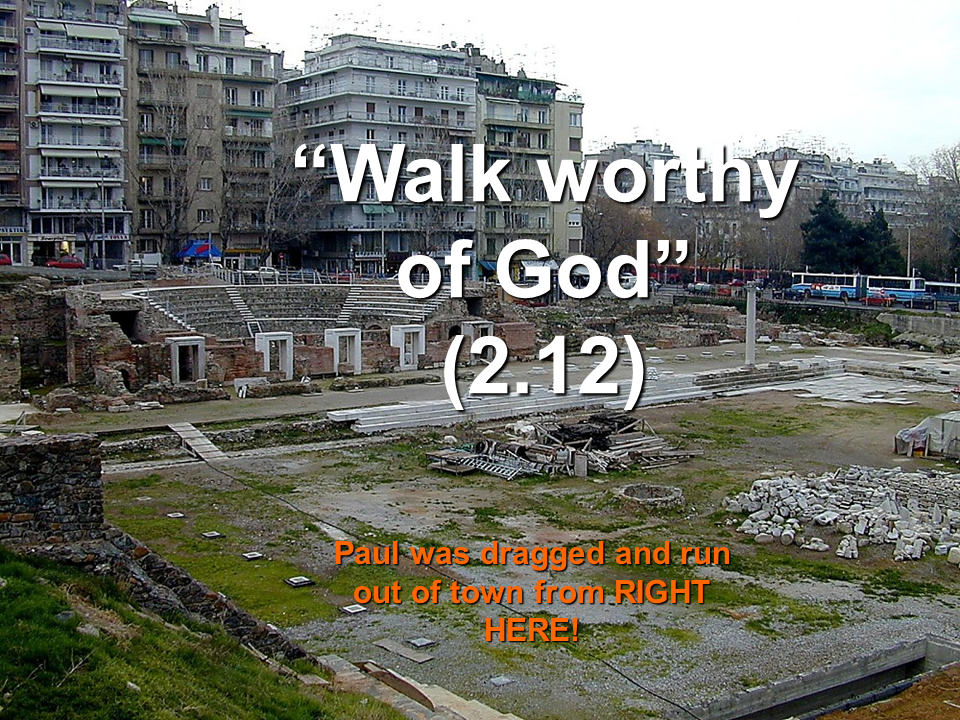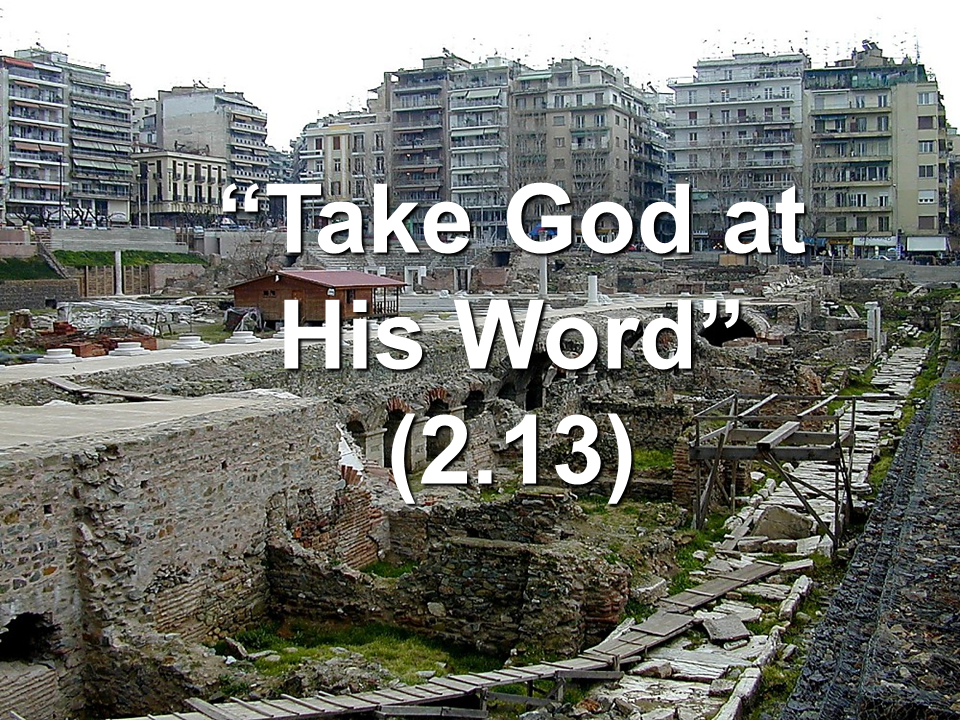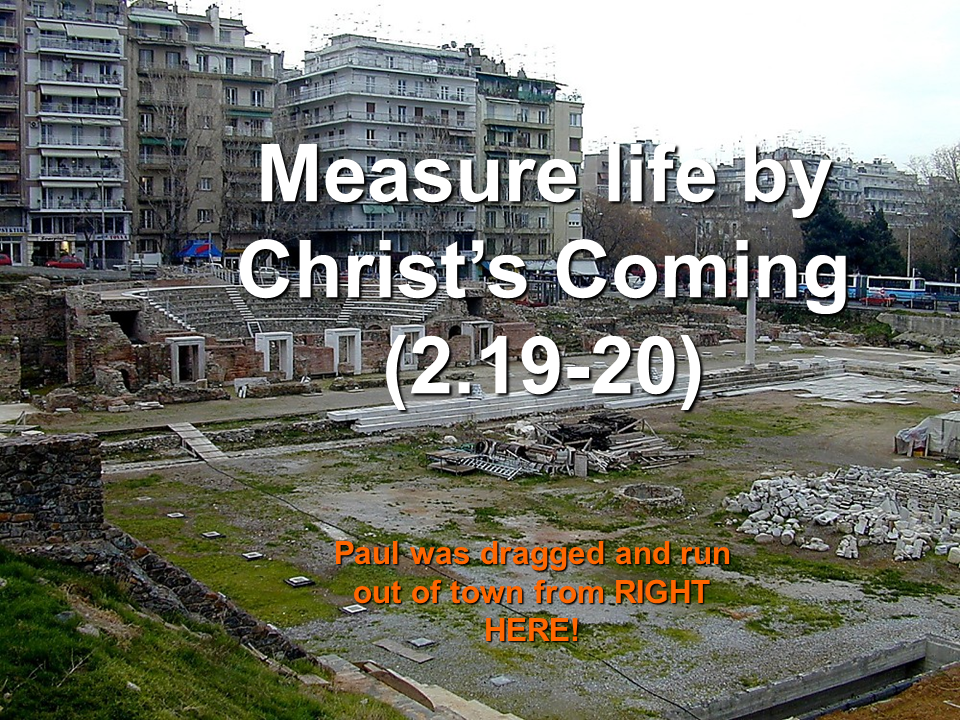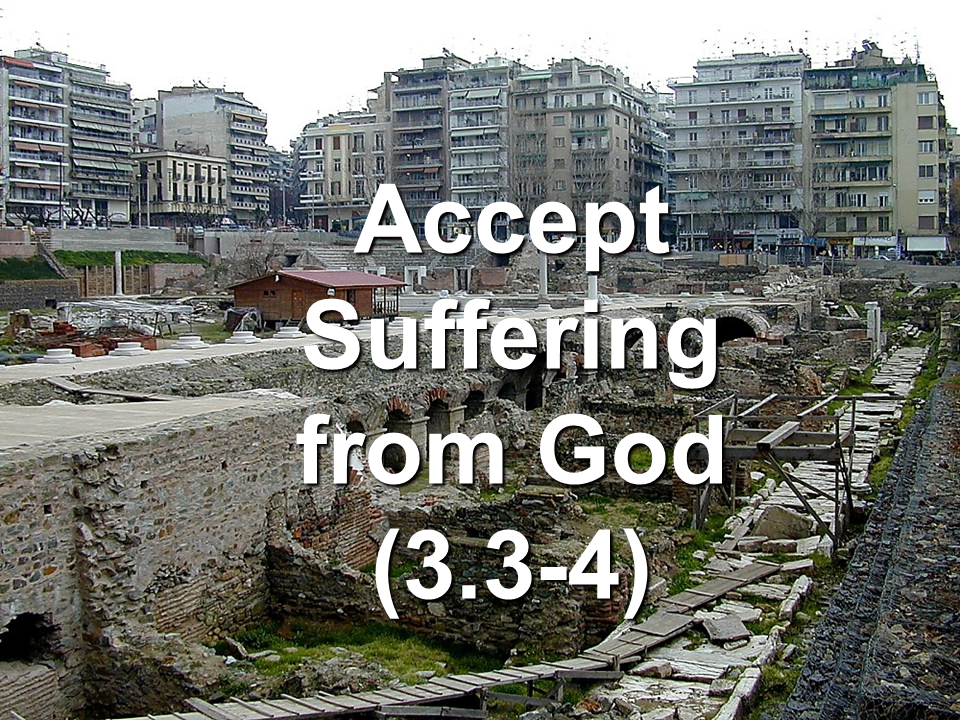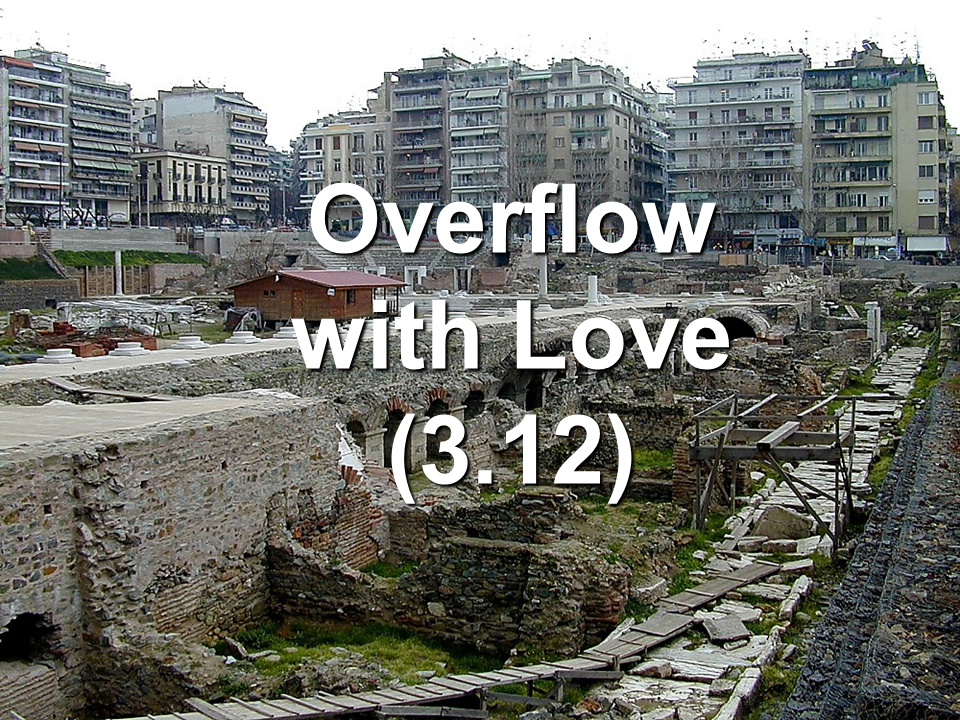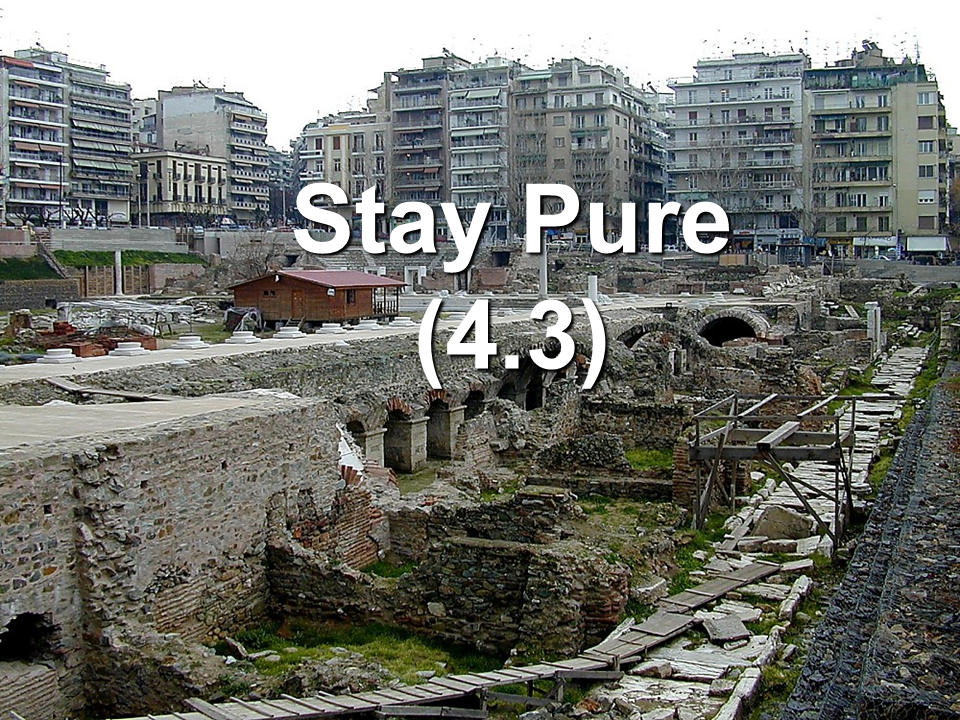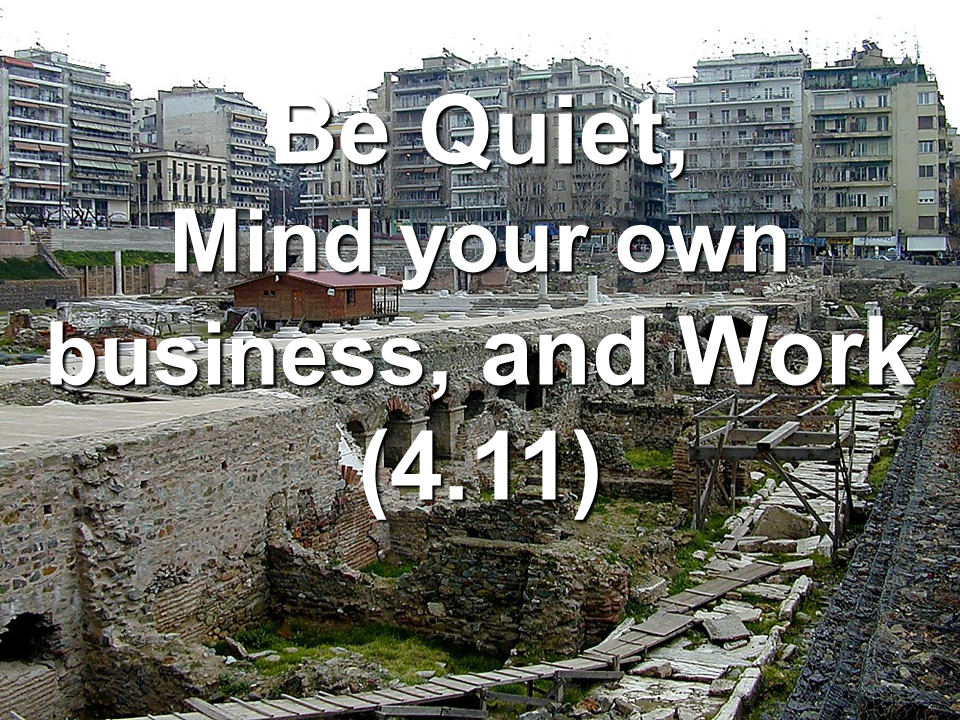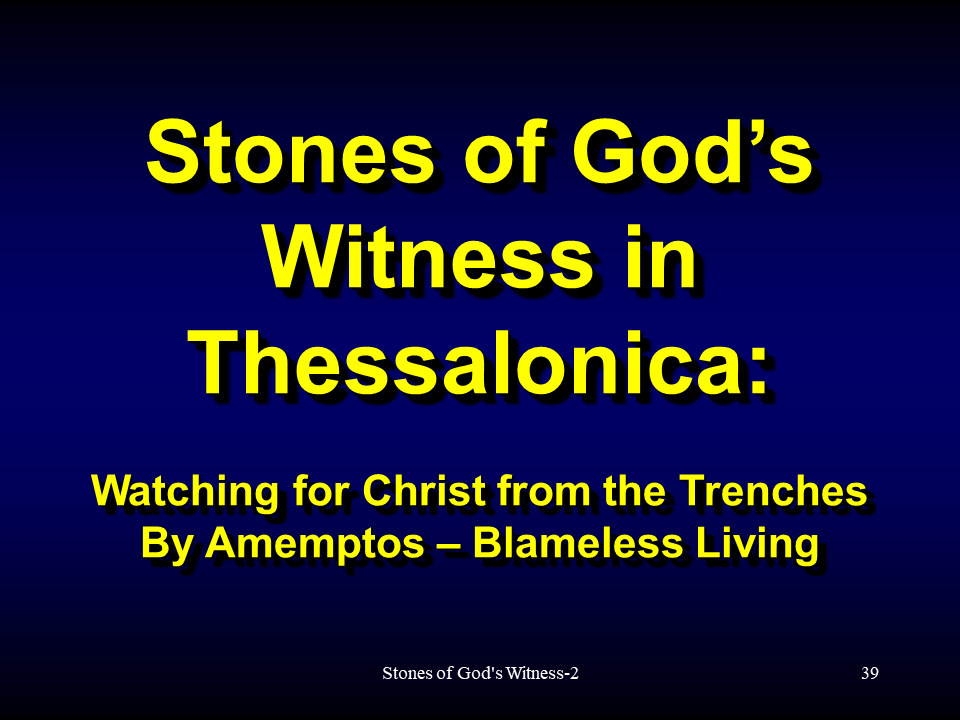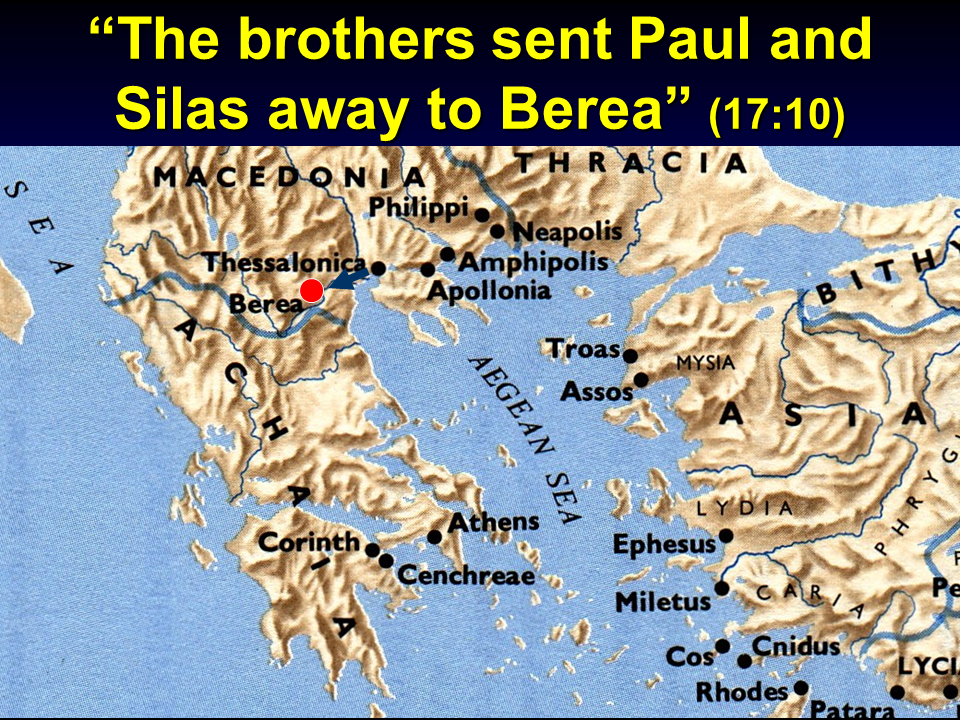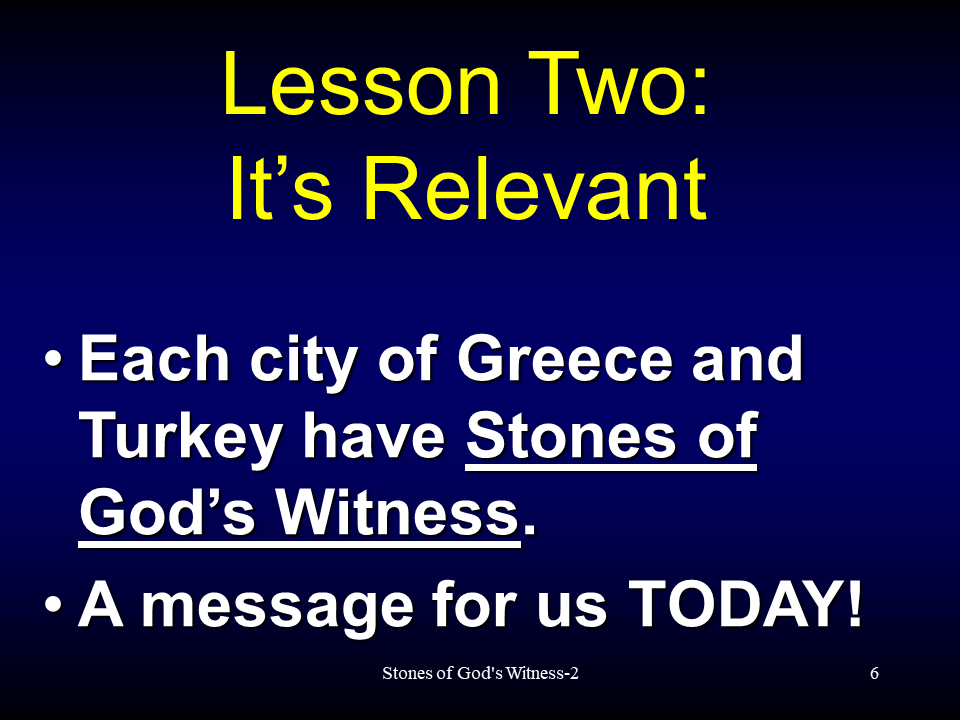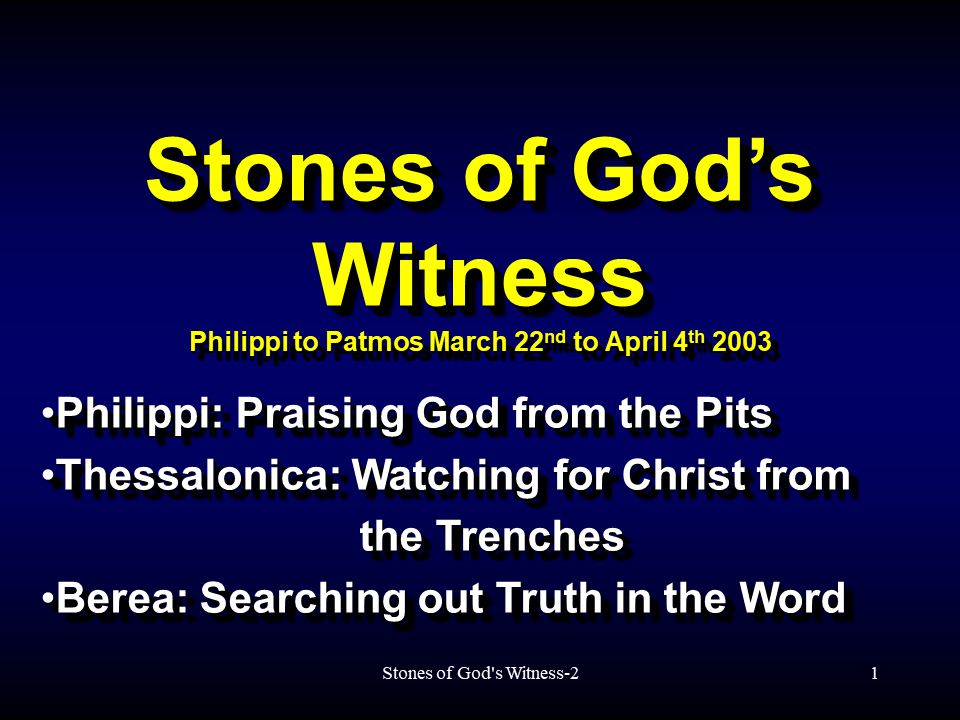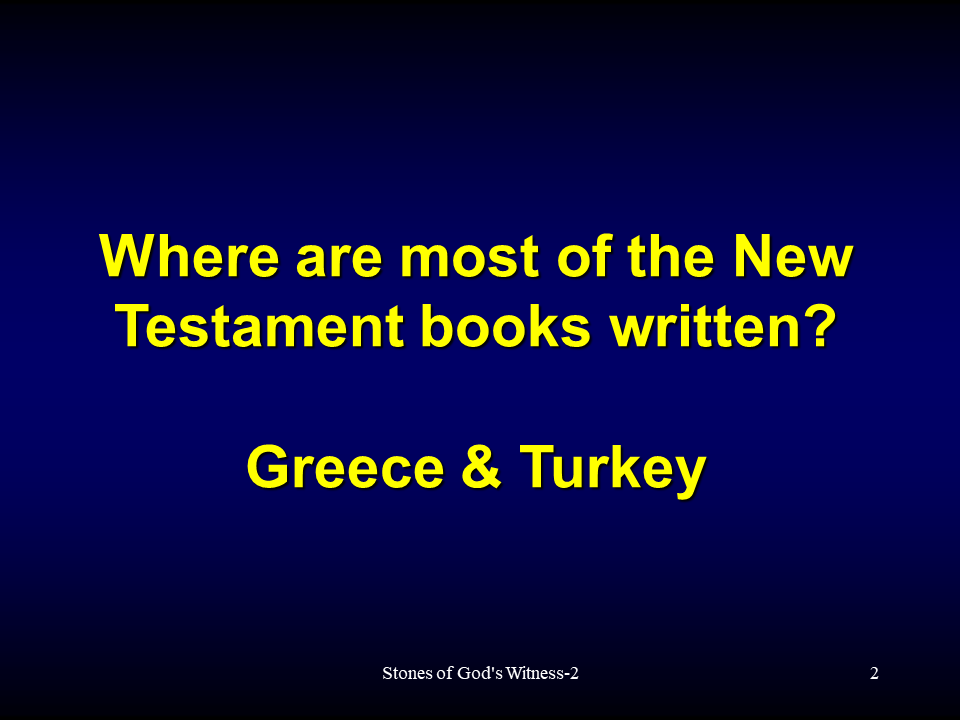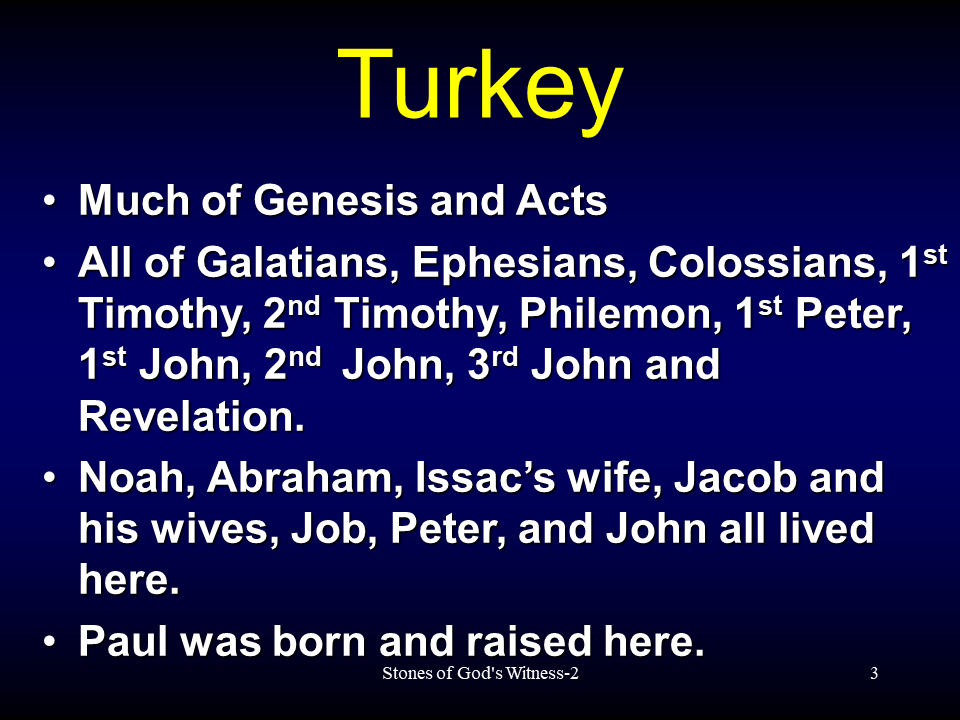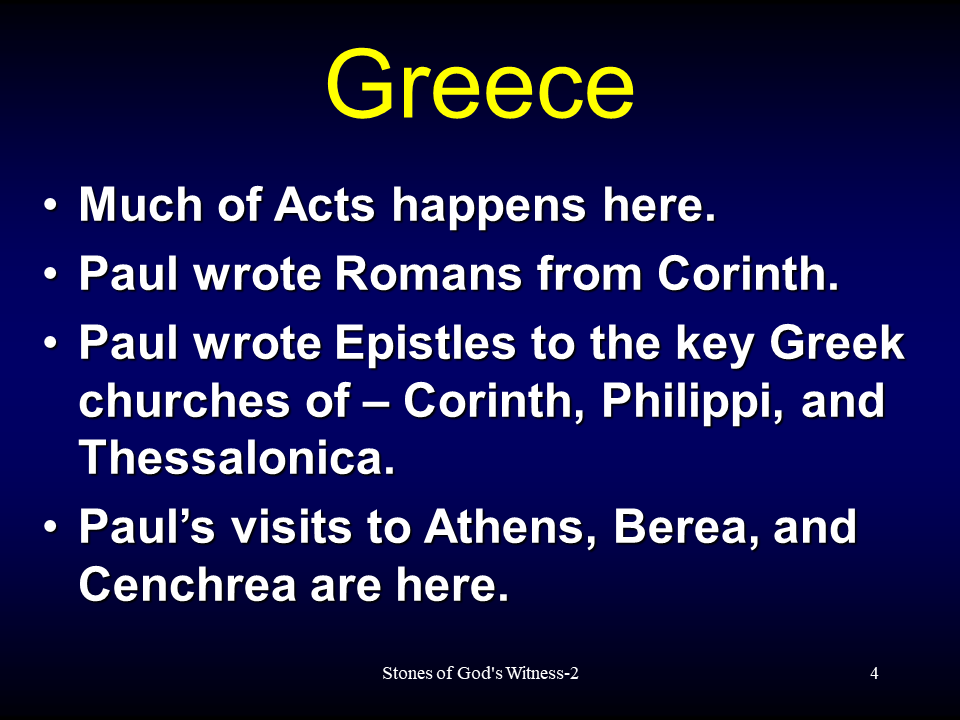NR2-10 WTB-36
020915PM
Stones of Gods Witness Berea -Philippi -Thessalonica-Athens
From Philippi to Patmos
STONES OF GOD’S WITNESS:
PHILIPPI – PRAISING GOD FROM THE PITS
THESSALONICA – WATCHING FOR CHRIST FROM THE TRENCHES
BERA – SEARCHING FOR TRUTH IN THE WORD
In the market[1] place of every city there stood a milestone giving the distance from Rome. In the market of “Rome the eternal” there stood a golden milestone, erected by Augustus, which described the capital city as the heart of this giant, pulsating organism of peoples.
- Between Alexandria and Asia Minor there was a daily shipping connection (Ramsay, Letters to the Seven Churches, 18, 435).
- According to Pliny one traveled from Spain to Ostia, the port of Rome, in four days, and in two days from Africa.
- The tomb inscription is known of a Phrygian merchant who not less than 72 times made the journey from Hierapolis, near Colossi in Asia Minor, to Rome, over 1,250 miles.
Without this notable world traffic the swift advance of early Christianity would have been inconceivable. Sea traffic was specially important to them, for early Christian gospel work was specially important to them, for early Christian gospel work was in great measure a labor in harbor cities, and especially so with Paul. “In the main the world of the apostle is to be sought where the sea wind blows.” One need only think of Paul’s sojourns in the ports of Caesarea, Troas, Ephesus, Athens, Corinth, and Rome.
Yet the land connections also were of the utmost importance. Even the most remote and isolated lands were opened up through roads and bridges. Already at that time a nearly complete network of well-built highways, protected by walls and fortresses, spread itself over the whole empire. “All roads lead to Rome.” On these imperial and main roads the messengers of the gospel later traveled, bringing to the world the joyful news of the Redeemer who had appeared. Some estimate Paul alone journeyed by land and water a total of more than 15,000 miles.
The CITY: PHILIPPI
THE MESSAGE: PRAISING GOD FROM THE PITS
- NEAPOLIS: This morning we transfer to the airport for our domestic flight to Kavala on the site of ancient Neapolis where Paul landed on the way to Philippi.
- PHILIPPI: Continue on a short drive to Ancient Philippi where we find two early Christian basilicas, traces of the Egnatian Way, which Paul followed from the harbor of Neapolis (ancient port of Philippi) on his first visit on European soil. View the Roman Forum, the Citadel, the ancient theater, and the Ledia’s brook.
- GLOBAL LANGUAGE Koine
- GLOBAL TRANSPORTATION Roman Roads
- GLOBAL LAW AND PEACE Pax Romana
- GLOBAL RELIGION Pantheon
- GLOBAL CULTURE Games
A New Way of Life –
CITIZEN OF HEAVEN OR EARTHDWELLERS?
The lost person has an entirely different orientation than we do. They are Earth-dwellers.
- Earth-dwellers live for their APPETITES Philippians 3:19a Their destiny is destruction, their god is their stomach, and their glory is in their shame. Their mind is on earthly things. (NIV).
- Earth-dwellers lived for their APPEARANCE Philippians 3:19a and their glory is in their shame. Their mind is on earthly things. (NIV).
- Earth-dwellers live for their ADDRESS Philippians 3:19c Their mind is on earthly things. (NIV). Did you know that in the book Revelation the word the Holy Spirit uses to describe lost people most often is “earth-dwellers”, people who only live for the here and now.
Paul said that believers are totally different. We are Citizens of Heaven as Paul taught them in Philippians 3.20. What would this communicate to these saints? Citizens of Rome were little fragments of Roman society. So when Paul compared being in Christ to being a Roman they understood what he meant. Do we?
- A Roman citizen spoke the language of Rome.
- A Roman citizen wore the dress of Rome.
- A Roman citizen observed the customs of Rome.
- A Roman citizen bore the titles of Rome.
- A Roman citizen kept the laws of Rome.
Thus, a clear concept came to the mind. Now, they were to use that concept to know how to live in the world. “Romans were stubbornly and unalterably Roman – never dreaming of being assimilated into the people around them.” Acts 16:20-21. How do we live in the world as citizens of Heaven? What is it?
- A Citizen of Heaven spoke the language of Heaven.
- A Citizen of Heaven wore the dress of Heaven.
- A Citizen of Heaven observed the customs of Heaven.
- A Citizen of Heaven bore the titles of Heaven.
- A Citizen of Heaven kept the laws of Heaven.
The CITY: THESSALONICA
THE MESSAGE: WATCHING FOR CHRIST FROM THE TRENCHES
How did Paul minister to them? He gave them the same plan he gave any other sinner. God’s recovery program is sanctification! When Paul proclaimed Christ to those deep in the dungeon of sin, he offered a recovery program. The vice grip of sin could be destroyed and the sin appetite abated.
Did Paul see lasting change? Resoundingly the Scriptures say YES! The vivid reality of washed saints, cleansed from the filth of sin’s prison, is the grandest picture the first-century church passed on to us.
Excavating the secret of this recovery program takes us to one of the ancient provinces of Rome and the city of Thessalonica
The CITY
Early this century a group of French archaeologists began to excavate the ancient ruins of a city along the coast of the Aegean Sea. As the work progressed they came to the NECROPOLIS or “City of the Dead”. Apart from the Necropolis was a separate area – a CEMETERY “sleeping place” KOIMEO. To the amazement of the archeologists was the presence of a unique word seldom if ever used in the ancient world: AMEMPTOS. Across each white marble slab deeply cut was a message that crossed the dust of centuries.
The CALLING
Across each white marble slab deeply cut was a message that crossed the dust of centuries. Open your Bibles to I Th. 3:13 – unblameable in holiness. Also 2:10 and 5:23
The CONDUCT
The apostle distilled the Christian life down to some bite sized pieces. These saints had no tapes. There were no bookstores to catch the latest titles. They had no Christian radio. There was no study bible to use and carry around. In reality it was only what they heard and could remember! So Paul reduced the entire life down to some neat little mottos to hold onto easily! We can call these: EXHORTATIONS for Unashamed Living:
| First Thessalonians 1:10 | A NEW GOAL: Wait for Son |
| First Thessalonians 2:12 | A NEW PLAN: Walk worthy of God |
| First Thessalonians 2:13 | A NEW AUTHORITY: Take God at His Word |
| First Thessalonians 2:14-20 | A NEW STANDARD: Measure all by Christ’s coming |
| First Thessalonians 3:3,4 | A NEW PERSPECTIVE: Accept suffering from God |
| First Thessalonians 3:12 | A NEW RESOURCE: Abound in love |
| First Thessalonians 4:3 | A NEW APPETITE: Stay pure |
| First Thessalonians 4:11 | A NEW LIFESTYLE: Be quiet, Mind own business, Work |
| First Thessalonians 4:18 | A NEW MINISTRY: Comfort one another |
| First Thessalonians 5:11 | A NEW FOCUS: Edify one another |
| First Thessalonians 5:16 | A NEW HABIT: Rejoice always |
| First Thessalonians 5:17 | A NEW CONTACT: Pray always |
| First Thessalonians 5:18 | A NEW AWARENESS: Be thankful |
- ATHENS/MARS HILL: We’ll share our morning devotional study sitting at Mars Hill where Paul was brought before the council. Finally, we reach the ‘harmony between matter and spirit’, the monument that ‘puts order in the mind’, the Parthenon. On a drive through the city we’ll see the National Library, the University, the Academy, the Presidential Palace, the Stadium, Temple of Zeus and Hadrian’s Arch. The afternoon is at leisure in the Platka where we sit, shop, snack, and stroll at the foot of the Acropolis. Dinner and overnight in Athens.
- CANAL OF CORINTH (DIOLKOS)/CORINTH: Then we tour Ancient Corinth where Paul worked with Aquila and Priscilla. Included are the First Century shops, the Agora, Temple of Apollo. At the Bema Seat we re-enact “The Greatest Day of our life” as we sit at the spot of 2nd Corinthians 5:10. Still gurgling under the ruins is the water of the springs of the mighty Acropolis above, which once fed the Fountain of Pirene.
- ACROCORINTH: Continue your drive up to Acrocorinth, in Paul’s time site of the great Temple of Aphrodite.
- CENCHREA: Return to Athens by way of Cenchrea where we renew our vows to the Lord as Paul once did. Late afternoon is at leisure to reflect on what we have seen. Dinner and overnight.
- THESSALONICA: Later, we drive to Thessalonica where we begin with a brief tour of the Biblical Thessalonica where Paul founded the Church in 49-50 A.D. THESSALONICA: This morning we take a tour of Thessalonica, Greece’s second largest city and capital of Macedonia, highlighting treasures of the ancient Byzantine and medieval eras. Included are the famous Byzantine St. Dimitri Church, Vlatadon Monastery, the University and Arch of Galerius.
- AMPHIPOLIS: Drive along Acts 17 following the ancient route of Paul, through mountain passes and plains to Amphipolis for a short stop to view the ancient Lion Statue. Dinner and overnight in Thessalonica.
- BEREA: After the tour, we will drive through the plains of Thessaly, visit the legendary home of the Greek Gods, continue on to Berea of Acts 17:11 where Paul remained for several days and the scriptures say the people were “more noble than in Thessaloniki.” Return to Thessaloniki where we will transfer to the airport for our domestic flight to Athens for dinner and overnight.
- RHODES: From the Acropolis there are breathtaking views of the great expanse of the Aegean Sea and St. Paul’s Bay where the Apostle cast anchor during his historic voyage to Ephesus.
- PATMOS: This morning we take a shore excursion to Patmos and head for the cave of the Apostle John remembering the Apocalypse of Jesus given there. Take a short journey to the village of Choara, where the Monastery of St. John is located, which was built 900 years ago and is rich in chapels and treasures. Outstanding are the frescoes in the church and the treasures of the museum. Afterwards visit the nearby Grotto of the Apocalypse, and see the silver niches in the wall that mark the pillow and the ledge used as a desk by the author of the Book of Revelation. Look at the three-fold crack made by the Voice of God to emphasize the honor of the Trinity.
- EPHESUS: This afternoon, we arrive in Kusadasi, Turkey, where our cruise will come to an end. After disembarkation, we will drive through the colorful town of Kusadasi and proceed to the Magnesian Gate, entrance to the ancient city of Ephesus. Our guided walking tour will take you through one of the most magnificent excavations in the world. After seeing the Odeon (concert hall), the Fountain of Trojan, the steam- heated Baths of Scolastika, the Temple of Hadrian and the Latrians, you will reach the Library of Celsus, adorned with its columns and statues, considered one of the most magnificent ruins in the world. We read Christ’s Letter to Ephesus by the Great Theater. Then relive Acts 19 and think of Paul’s ministry here at the largest theater in antiquity, with a capacity of 24,000 people. At the end of the tour, our motor coach will be waiting to take us to Pamukkale for dinner and overnight in our hotel.
- HIEROPOLIS: This morning we take a brief tour of Pamukkale, where we visit the Roman spa of Hierapolis.
- Colosse: Just 6 miles away on the horizon is the mound or tel of Biblical Colosse, as we depart Hieropolis we can see the Lycus Valley and the site in the distance of Colosse that received Paul’s great letter of Colossians.
- LAODICEA: We drive to Laodicea to see the remains of one of the Seven Churches. Laodicea church was a branch of Ephesus, as were the churches of Hierapolis and Colossea. Proceed to the Necropolis, the Temple of Apollo and the Theater and Roman baths.
- PHILADELPHIA: Then we depart Pamukkale and head for Philadelphia, the city of Brotherly Love, founded by Attalus II, and
- SARDIS: Sardis, the capital of ancient kingdom of Lydia, with its gymnasium and marble paved synagogue, where King Croesus ruled. Philadelphia and Sardis are two of the Seven Churches of Revelation.
- SMYRNA: We end the day in Izmir (ancient Smyrna) site of one of the Seven Churches.
- PERGAMUM: Begin the day with a drive to and a tour of Pergamum, another one of the Seven Churches and capital of a large and powerful pre-Roman kingdom. It is here that the first Christian was put to death by the Roman state. Visit the Church of Pergamum, the Homonym Church and the Acropolis with its pagan temples including the Altar of Zeus, which is mentioned as the “Throne of Satan” in the Book of Revelation. We will also visit the health center of Asclepion, the Agora and theater.
- THYATIRA: Later drive to Akhisar, Thyatira, one of the Seven Churches. The church of Thyatira had tolerated the works of Jezebel. Continue on to Canakkale. Dinner and overnight in Canakkale.
- TROAS: Today we visit the ancient city of Troy only rediscovered by the German archaeologist Heinrich Schliemann in 1873, with its 4000 year old history recalling the epic struggle of the Iliad.
SUMMARY: Turkey
Turkey is an amazing country with so much history and so many civilizations that it boggles the mind. If you ever get the chance to go, it is a must see nation and is much larger than Israel with many more historic sites, being the size of Texas and the state of Washington put together. Here is just a partial list of the biblical and historical locations in Turkey:
Ani Assos Attalia (Antalya) Bythinia Cappodocia Carchemish Caria Cilicia Cnidus Cos Cudi Dagi (At least two of them and possibly more) Cyprus Derbe Ephesus Euphrates River Galatia Garden of Eden Haran (Harran) Iconium (Konya) Istanbul (Byantium, Constantiople) Kars Laodicea Lycaonian Cities Lycia Lystra Miletus Mountains of Ararat (Urartu) Myra Mysia Pamphylia Paphos Patmos Island Perga Pergamum Philadelphia Phrygia Pisidian Antioch Pontus Provinces of Asia Rhodes Samos Sardis Seleucia Smyrna (Izmir) Syrian Antioch Tarsus Thrace Thyatira Tigris River Troas Troy
From a Bible perspective, it is amazing and faith building to actually see the historic locations discussed through the Bible. Selections of Genesis and Acts along with the entirety of Galatians, Ephesians, Colossians, Timothy, Philemon, 1 Peter, John’s letters, and Revelation were written to or about people living in modern-day Turkey. We follow the order that the letter of Revelation from the apostle John probably took along the existing roads of the first century.
People and places that had influences and history in Turkey include possibly the Noah, Abraham, Isaac’s wife, Jacob, Jacob’s wives, Laban, Job, all the way down to the Hittites, Urartians, Gordians, Assyrians, Phrygians, Lydians, Greeks, Romans, Marc Anthony and Cleopatra, many Roman Emperors, New Testament Christians, the Apostles Paul, Peter, and John, many New Testament and early Christian churches, Seljuk Muslims, the Ottoman Empire, and Ataturk.
[1] Quoted from Erich Sauer

